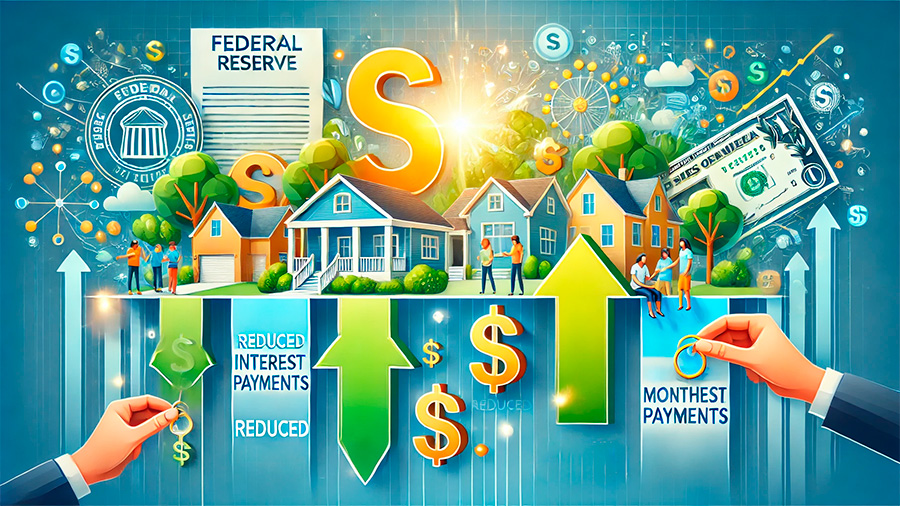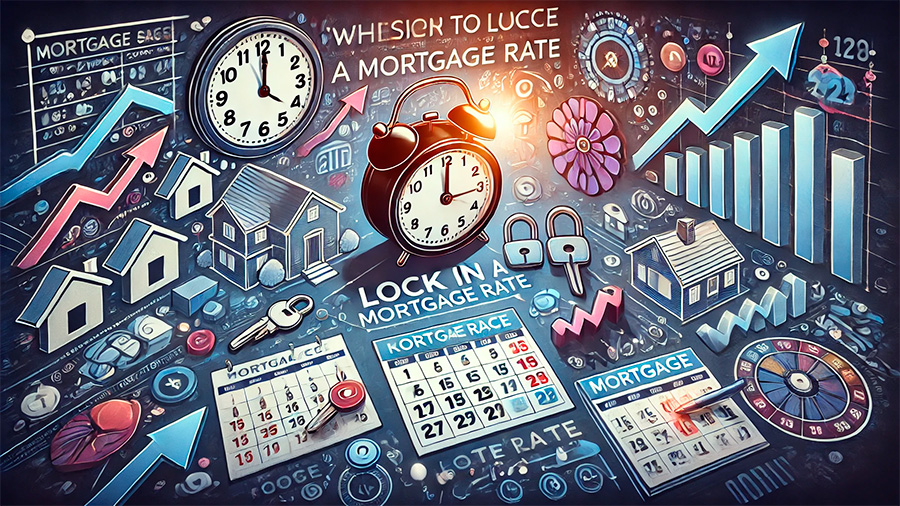The Federal Reserve (Fed) plays a pivotal role in the U.S. economy, particularly when it comes to influencing interest rates. Changes in the federal funds rate, often referred to as the Fed rate, can have significant ripple effects on the cost of borrowing, especially for mortgages. When the Fed adjusts its rate, it impacts everything from credit card interest to mortgage loan affordability, ultimately influencing homebuyers’ purchasing power.
For prospective homebuyers, understanding how Fed rate changes affect mortgage rates is crucial. These fluctuations can determine the cost of monthly payments, the total interest paid over the life of a loan, and whether now is the right time to buy a home. This article explores how the Fed’s rate decisions influence mortgage affordability and how homebuyers can navigate these changes.
What Is the Fed Rate?
The federal funds rate is the interest rate at which banks lend to one another overnight to maintain their reserve requirements. While this may seem unrelated to mortgage loans, it has a direct impact on broader interest rates across the economy, including those for mortgages, personal loans, and credit cards. When the Fed raises or lowers its rate, it’s essentially making borrowing more expensive or cheaper, which filters through to consumer interest rates.
Direct vs. Indirect Effects on Mortgage Rates
While the Fed doesn’t set mortgage rates directly, its decisions influence the broader financial environment in which banks and mortgage lenders operate. When the Fed raises rates, it increases the cost of borrowing for banks, which in turn pass those higher costs onto consumers in the form of higher interest rates on loans, including mortgages.
Short-term vs. long-term rates: The Fed rate directly affects short-term interest rates, such as those on adjustable-rate mortgages (ARMs) and home equity lines of credit (HELOCs). However, its impact on long-term fixed mortgage rates is more indirect, typically influencing investor sentiment and broader economic conditions.
Market expectations: Mortgage rates are also influenced by expectations of future Fed rate changes. If investors anticipate a series of Fed rate hikes, mortgage rates often rise in anticipation.
By understanding the relationship between Fed rate decisions and mortgage rates, homebuyers can make more informed decisions about when to lock in rates and how to navigate fluctuating loan costs.
How Higher Fed Rates Increase Mortgage Loan Costs
When the Fed raises rates, it leads to higher borrowing costs, which can significantly affect mortgage loan affordability. Higher mortgage rates mean that borrowers will pay more in interest over the life of the loan, leading to higher monthly payments and increased overall costs.
Impact on Monthly Payments
One of the most immediate ways higher mortgage rates affect affordability is through increased monthly payments. Even a small increase in the interest rate can make a noticeable difference in how much homebuyers pay each month.
Example: On a $300,000 mortgage with a 30-year fixed-rate loan, an interest rate increase from 3% to 4% would raise the monthly payment by roughly $140. Over the life of the loan, this adds up to over $50,000 in additional payments.
Reduced purchasing power: As monthly payments increase, homebuyers may need to adjust their budget, potentially buying a less expensive home to keep their payments affordable.
For homebuyers, higher Fed rates mean either taking on higher monthly costs or reducing the size of the loan they can afford.
Total Interest Paid Over the Life of the Loan
Higher mortgage rates also mean that homebuyers will pay more in interest over the life of the loan. Since mortgage loans often extend for 15 to 30 years, even small rate increases can lead to substantial added costs in total interest paid.
Increased lifetime costs: For a 30-year mortgage, a rate increase of just 1% can result in tens of thousands of dollars in additional interest payments over the loan term.
Long-term financial impact: Higher interest rates not only affect monthly payments but also the total cost of owning a home, which can impact long-term financial goals like retirement savings or future investments.
Understanding how rate increases affect the total cost of a mortgage can help borrowers plan for the long-term financial implications of homeownership.

How Lower Fed Rates Make Mortgages More Affordable
Conversely, when the Fed lowers rates, borrowing becomes cheaper, which can have a positive effect on mortgage loan affordability. Lower mortgage rates reduce both monthly payments and the total interest paid over the life of the loan, making homeownership more accessible to a broader range of buyers.
Lower Monthly Payments
When mortgage rates drop, homebuyers can secure lower monthly payments, allowing them to afford a larger home or save money on a similar-priced property. This can make homeownership more appealing during periods of lower interest rates.
Example: On the same $300,000 mortgage, if the interest rate drops from 4% to 3%, the monthly payment decreases by around $140. Over the life of the loan, this results in significant savings.
Increased purchasing power: Lower rates allow buyers to qualify for larger loans while keeping their payments within budget, giving them more flexibility in their home search.
During periods of lower Fed rates, homebuyers can lock in more affordable monthly payments, making homeownership more financially manageable.
Reduced Long-Term Interest Costs
In addition to lowering monthly payments, reduced mortgage rates also decrease the total amount of interest paid over the life of the loan. This makes homeownership more cost-effective in the long run, freeing up funds for other financial goals.
Example: On a 30-year fixed-rate loan, a reduction in the mortgage rate from 4% to 3% can save tens of thousands of dollars in interest payments over the term of the loan.
Wealth-building opportunities: With lower long-term costs, homeowners can use the money saved on interest to invest in other areas, such as retirement accounts or home improvements.
By securing a mortgage during a period of lower rates, homebuyers can reduce their overall cost of borrowing and build wealth more efficiently over time.
How Adjustable-Rate Mortgages (ARMs) Are Affected by Fed Rate Changes
Adjustable-rate mortgages (ARMs) are particularly sensitive to changes in the Fed rate because their interest rates are typically tied to short-term benchmarks like the prime rate or LIBOR, which move in tandem with Fed rate adjustments. Unlike fixed-rate mortgages, which lock in a rate for the life of the loan, ARMs fluctuate over time, making them more volatile.
Short-Term Benefits During Low-Rate Periods
During periods of low Fed rates, ARMs can be an attractive option for borrowers who want to take advantage of lower initial rates. The lower rates during the initial fixed period (typically 5, 7, or 10 years) can result in lower monthly payments compared to a fixed-rate mortgage.
Lower initial rates: ARMs often offer lower rates than fixed-rate mortgages during the introductory period, which can make homeownership more affordable in the short term.
Potential savings: If the Fed keeps rates low for an extended period, borrowers with ARMs may benefit from lower payments even after the initial fixed period ends.
However, borrowers need to be mindful that ARMs can become more expensive once the rate adjusts, especially if the Fed raises rates during or after the initial fixed-rate period.
Long-Term Risk During Rate Hikes
The primary risk of ARMs is the potential for higher payments after the initial period if the Fed raises rates. As the ARM interest rate adjusts based on market conditions, borrowers could see significant increases in their monthly payments.
Rate reset risk: Once the fixed-rate period ends, ARM interest rates can increase, leading to higher monthly payments. If the Fed has raised rates significantly, borrowers could face substantial payment increases.
Uncertainty: The unpredictability of future rate changes makes ARMs riskier than fixed-rate mortgages for long-term planning, especially during periods of economic uncertainty.
Borrowers considering ARMs need to evaluate their ability to handle potential payment increases in the future, particularly if they expect the Fed to raise rates.

Should You Lock In Your Mortgage Rate?
For homebuyers or those looking to refinance, timing can be crucial when deciding whether to lock in a mortgage rate. Locking in a rate means securing the current interest rate for a set period, typically 30 to 60 days, regardless of future Fed rate changes. However, if rates are expected to fall, it may be worth waiting to secure a better deal.
When to Lock In
If you anticipate that the Fed will raise rates in the near future, it may be wise to lock in your mortgage rate to protect against potential rate hikes. This can help you avoid higher monthly payments and increased borrowing costs down the line.
Rate hikes expected: If economic indicators suggest that the Fed is likely to raise rates, locking in your mortgage rate can safeguard against rising interest costs.
Avoiding uncertainty: Locking in a rate provides peace of mind, allowing you to budget your mortgage payments more accurately without worrying about potential rate fluctuations.
When to Wait
If the Fed is expected to lower rates, or if mortgage rates are trending downward, it may be beneficial to wait before locking in your mortgage rate. This allows you to potentially secure a lower rate and reduce your overall borrowing costs.
Falling rate environment: If market conditions suggest that rates will decline, waiting to lock in could lead to significant savings on monthly payments and total interest paid.
While waiting for lower rates can be advantageous, it’s essential to balance the potential benefits with the risk that rates could rise unexpectedly.
Final Thoughts: Navigating Fed Rate Changes and Mortgage Affordability
Fed rate changes play a significant role in determining mortgage loan affordability. As the Fed raises or lowers rates, it directly impacts borrowing costs, influencing both monthly payments and the total interest paid over the life of a loan. Understanding how these rate changes affect mortgage affordability is crucial for homebuyers looking to make informed decisions about when to buy a home or refinance an existing mortgage.
Whether considering a fixed-rate or adjustable-rate mortgage, staying informed about Fed rate trends and broader economic conditions can help you navigate the complexities of mortgage affordability. By making strategic decisions based on interest rate trends, homebuyers can minimize their borrowing costs and achieve more financial flexibility in their homeownership journey.
